#California art
Explore tagged Tumblr posts
Text

Oceanside Purchase Print | Follow on Instagram
#photography wall art#coastal photography#coastal home decor#interior design#palm trees#tropical#Pacific Ocean#California#California art#Oceanside#tropical beach
14 notes
·
View notes
Text
CHICANO ART MOVEMENT visits: “Rasquachismo” 2024
On Saturday 05/11/24, we visited Huntington Beach Art Center to view “Rasquachismo” in the city of Huntington Beach, California.
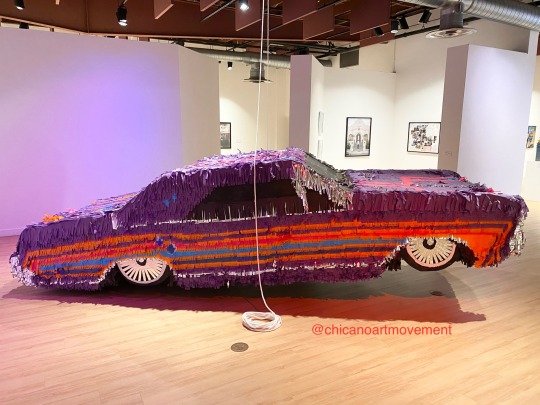
(“Beyond Timeless” by Justin Favela, 2022)
We learned from the mission statement that: “‘Rasquachismo,’ [is] a multi-media exhibition celebrating the aesthetics and transformative power of Lowriders. Featuring work by William Camargo with Alkaid Ramirez, Justin Favela, Stephanie Mercado, Arturo Meza Il, Aaron Moctezuma, Jose Manuel Flores Nava, Alicia Villegas-Rolon, and Cora J. Quiroz.”
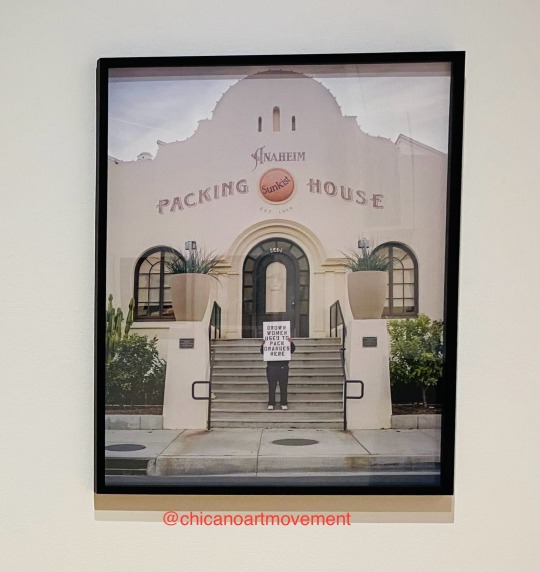
(“Anaheim in Flux” by William Camargo with Alkaid Ramirez, 2024)
“Emerging from the barrios of Southern California, lowriding brought forth a long resistance against the American Dream and dominant idealist norms that attempted to anglicize the young Chicanx individual. Forces of the Anglo-American culture did all it could to disrupt and omit the lowrider. From individual traffic stops to passing county-wide laws, all were attempts to take the lowrider off the streets. Low and slow, their metallic bodies transfigured in response. Now, unapologetically visible, lowriders glisten in candy-colored paint and dance with the aid of hydraulics. The power of lowriding extends beyond the car's aesthetics, however. It has become a rasquachismo expression of Mexican-American, and, eventually, Chicanx identity.”

(“Highland Park” by Stephanie Mercado, 2023)
A favorite of Robert’s at the “Rasquachismo” exhibit was Stephanie Mercado’s “Highland Park.” Through a little research, we learned that “‘Highland Park’ honors the cultural richness of the area including its history, diversity, and its valuable contributions to the broader arts and culture sector of Los Angeles. Utilizing imagery and icons sourced from the neighborhood, this piece celebrates the enduring local landmarks and showcases the architectural diversity that defines the area. Simultaneously, it pays homage to the artists and art spaces that have played a vital role in making Highland Park a vibrant and lively neighborhood for generations.”
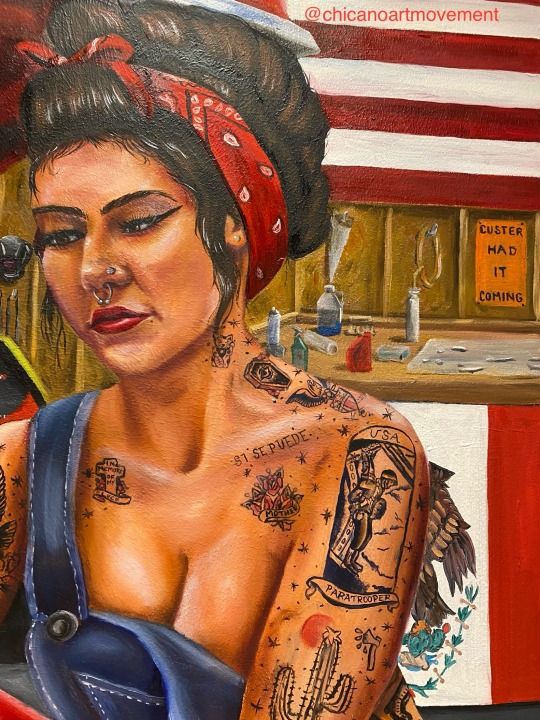
(Detailed view of “We Can Dream” by Cora J. Quiroz, 2022)
From the museum ephemera, we learned that this painting entitled “We Can Dream” by Cora J. Quiroz is part of a series called “Not Your Typical Rosie.”
The artist states: “I paint women in a way that removes them from being acquiescent muses in typical artworks. From action, body language, and clothing, to expression, I ensure the women I paint have active roles of inspiration, movement, and storytelling. Raised by my mother, I learned about my family’s history through oral tradition. Rather than beng inspred by male-dominated stories in media, I became inspired by the Indigenous and Mexican women of my family, taking spaces where they were not expected.
The simplest acts typical for a man to perform, can often be taboo for women, such as working in the car industry. Despite this, for many years there have been women who have gone against the grain to become whoever they pleased to be, going beyond the WWII icon associated with strong women. These are the stories that inspire my work.”
(“El Cuento de los Panes: A Community Installation Inspired by Dr. Tomás Ybarra-Frausto” organized by the Exhibition Design students at Laguna College of Art and Design, 2024)
The exhibition statement shares that the term rasquachismo was “coined by Chicano scholar and art critic Tomás Ybarra-Frausto to describe ‘an underdog perspective, a view from los de abajo’ (from below) in working class Chicanx communities which uses elements of ‘hybridization, juxtaposition, and integration’ as a means of empowerment and resistance.”
The Huntington Beach Art Center presents “Rasquachismo” curated by Laura Black until June 1st, 2024 with their last programming event of an artist discussion is set for Saturday May 25th, 2024 from 1pm to 2:30pm.
#rasquachismo#huntington beach#chicano art#contemporary art#chicana art#photography#oil paintings#orange county#hb#car culture#california art#mixed media art#art history#chicanx
20 notes
·
View notes
Text

Rudy Rojas (American), Untitled, 1981. Oil on canvas, 21½ x 28½ in. | 54.6 x 72.4 cm.
#art#artwork#modern art#contemporary art#20th century art#20th century modern art#20th century contemporary art#American art#modern American art#contemporary American art#American artist#California art#Californian artist#Latino art#Latino artist#Chicano art#Chicano artist#Rudy Rojas#California Dreaming#cars#fast cars
13 notes
·
View notes
Text

Cliffs in mendocino from a plein air competition
#oil painting#painting#art#fine art#original art#traditional art#art study#pleinair#plein air#mendocino#botanical#cliffs#ocean#waves#california#california art
48 notes
·
View notes
Text


After hearing the sad news of Shelley Duvall's passing, I decided to watch a few films from her filmography and started with 3 Women, released in 1977. Based on a dream writer/director Robert Altman had, the film follows Duvall and Sissy Spacek as their lives and identities intertwine in the California desert. Later a third woman played by Janice Rule, becomes more important in the pair’s world.
Using reflections, water, mirrors, mirrored actions, and twins, Altman creates a mysterious space for these women to inhabit. Adding to the unsettling energy of the film are a series of murals created by artist Bodhi Wind (Charles Kuklis).
It’s definitely worth a watch, with an ambiguous ending that has been subject to many interpretations.
youtube


















#3 Women#Robert Altman#Shelley Duvall#Sissy Spacek#Weekend Watch#Janice Rule#California Art#Bodhi Wind#California Film#Charlie Kuklis#Desert Springs#Dreams#Film#Film and Video#Identity#Murals#Palm Springs#RIP#Twins#Youtube
3 notes
·
View notes
Text
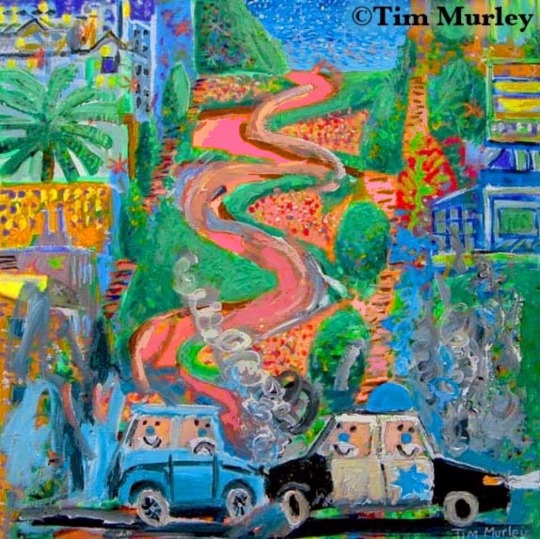
Fender bender at Lombard street. 🚙⚡️🚓(mixed media on canvas)🌞
#pop art#folk art#basquiat#keith haring#san francisco#san fransisco 49ers#san franciso bay#sf#San fran#pier 39#fort mason#police car#car crash#fender bender#Lombard#lombard street#california artist#California art#andy warhol#urban sketch#cityscape painting#plein air#plein air painting#grandma moses#traffic accident#drivers education#car accident#street art#david hockney#julian schnabel
3 notes
·
View notes
Text

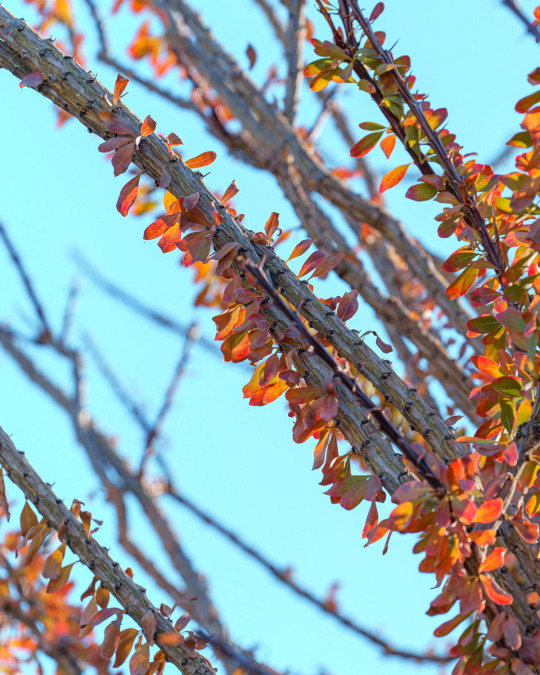

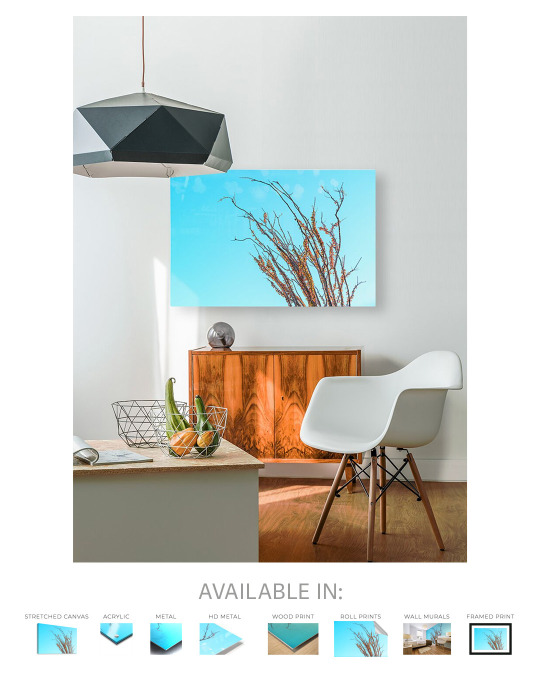
My new print, "Ocotillo in the Desert". Available through my online shop: https://shop.tomwindeknecht.com
#artwork#art for sale#ocotillo#desert#palm desert#california#california artist#california art#desert art#cactus#joshua tree#native plants#mojave desert#wall art#local artist#home decor
5 notes
·
View notes
Text

Salvation Mountain, 2023
#cammi mcdermott#ethel cain#salvation mountain#california#california art#destination art#religion#christianity#colorful#slab city#desert art#desert#united states#lana del rey#usa#off the grid#abandoned#abandoned west#west coast
5 notes
·
View notes
Text
Hidden California: Visiting The Salton Sea
The Salton Sea After reading about the worst environmental disaster in California history, I was fascinated about the concept of rapid change and how the Salton Sea went from a tourism hotspot to an abandoned area. Bombay Surf In the 1950s, the Salton Sea was a very attractive and famous travel destination, in the 1970s the lake started to experience contamination from agricultural runoff, the…

View On WordPress
#abandoned town#bombay beach#california art#california desert#desert art#desert lake#ecological disaster#fine art prints#ghost town#hidden california#nostalgia#photography prints#salton sea#unique photos#visual arts#visual storyteller#wall art photography
3 notes
·
View notes
Text

Follow on Instagram | Purchase Print
#surfer#surfing#surf photo#surfboard#surf photography#full moon#California#california art#photography prints#interior design
6 notes
·
View notes
Text
CHICANO ART MOVEMENT: “Las Manos de Aztlán” art talk with Emmanuel C. Montoya 2023/2024
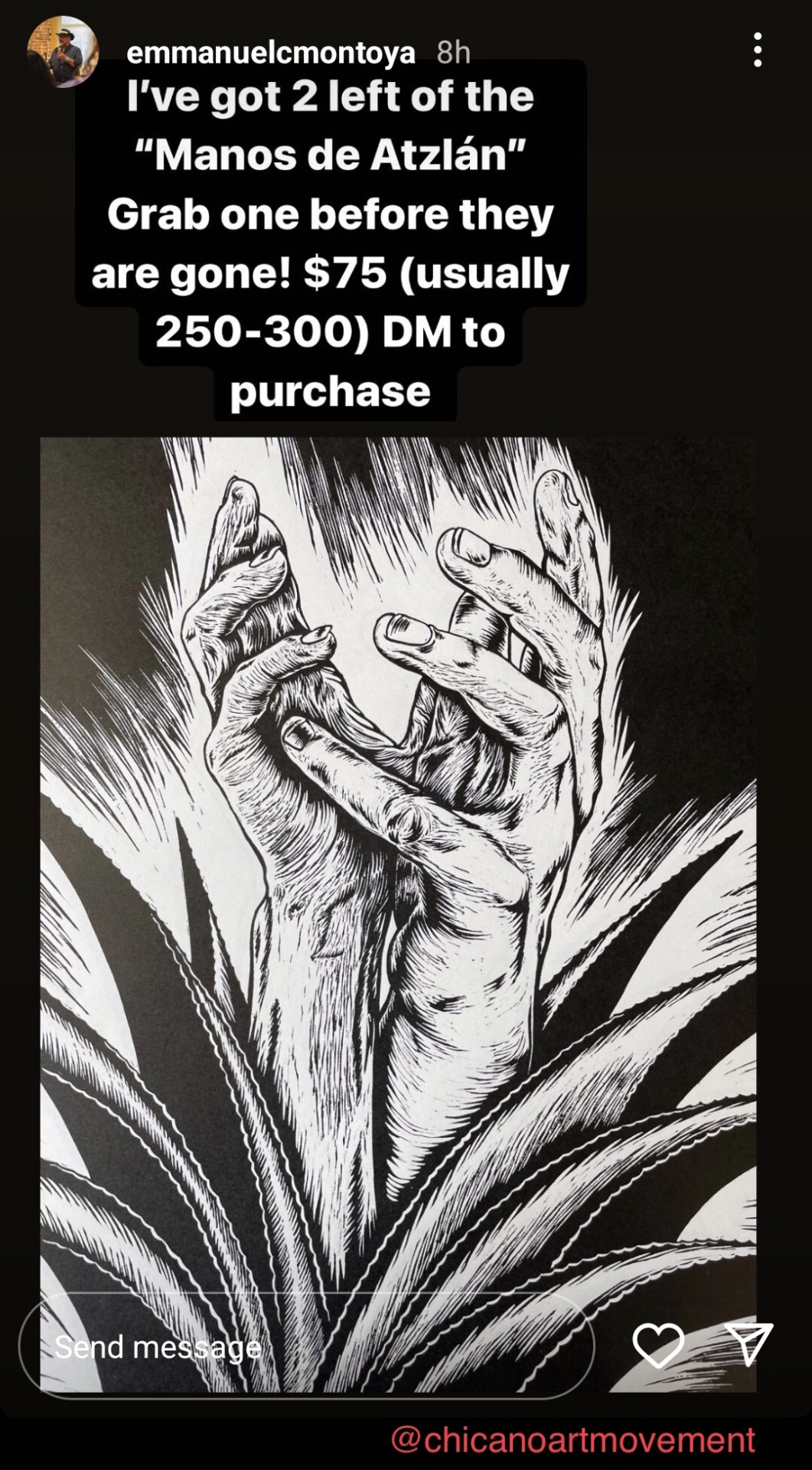
(Social media capture of Montoya print sale.)
In early May 2023, the Apachicano artist Emmanuel C. Montoya, Bay Area creative, announced through his social media the availability to purchase his vintage prints. For Robert, it was the prime opportunity to add an artwork by Montoya who for many years has dedicated himself as an artist to the Chicana/Chicano community. Within a few moments and with technology’s help, we were in direct contact with Emmanuel and became patrons to the piece titled “Las Manos de Aztlán” - a linocut print measuring 16 inches by 17 inches and was specifically made for the Chicana/Chicano students and faculty on the campus of University of California at Santa Cruz in 1989.
A few weeks later and upon the arrival of the print, we unrolled to survey the “Las Manos de Aztlán” piece and were very intrigued to learn more about it. We messaged Montoya regarding the safe arrival of his artwork and inquired if he was available to answer a few questions about the piece itself. We explained to the artist that we wanted to ascertain more information about the “Las Manos de Aztlán” in order to write a future article.
Montoya replied that he was open to talking more over the phone and we coordinated a future & mutual date to go in-depth about his “Las Manos de Aztlán” print. We called el maestro Emmanuel C. Montoya and we were greeted with warmth y gusto from the artist who welcomed us with a “Que viva la Raza!” After exchanging introductions and stating it was our pleasure to speak with a great community member, artist, elder, and activist, Anita took the lead with this on this one-on-one interview with Emmanuel C. Montoya.
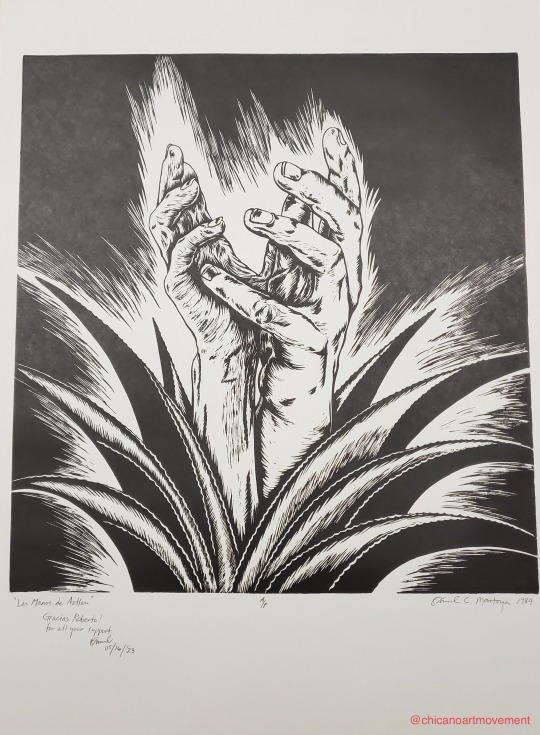
(View of “Las Manos de Aztlán” by Emmanuel C. Montoya, 1989)
When asked about the history and background surrounding the “Las Manos de Aztlán” print, Montoya shared that in 1989 he “was approached by Francisco X. Alacrón, the famous Chicano poet. He was teaching at UC Santa Cruz, at that time, and of course was involved with the Chicano students, at that time. I met him of course in the Mission in San Francisco back then in the ‘80s & ‘70s - very vibrant art community in the Mission at that time. So, he approached me. He’d seen my work and liked my work. He approached me about doing this poster celebrating the Chicano students at UC Santa Cruz. It was the ten year anniversary.”
Emmanuel explained that he featured the maguey at the center of the piece due to la planta’s resilience and adversity against many elements as well as its important symbolization in ancient and contemporary cultures. Montoya happily retold a funny moment of enlightenment when looking at “Las Manos de Aztlán” that “if you looked at the image,” said the artist, “it’s two hands - five and five - which adds up to ten. Of course, I didn’t know that. Somebody else pointed that out to me.” He laughed and continued: “Este so…the idea, of course, is my idea. I thought about the maguey plant which is an important symbol in pre-Columbian/Mexicano/Chicano history and culture. I have the two hands growing from the maguey plant and it, of course, symbolizes their ten years” as a Chicana/Chicano organization on the UC Santa Cruz campus in 1989.
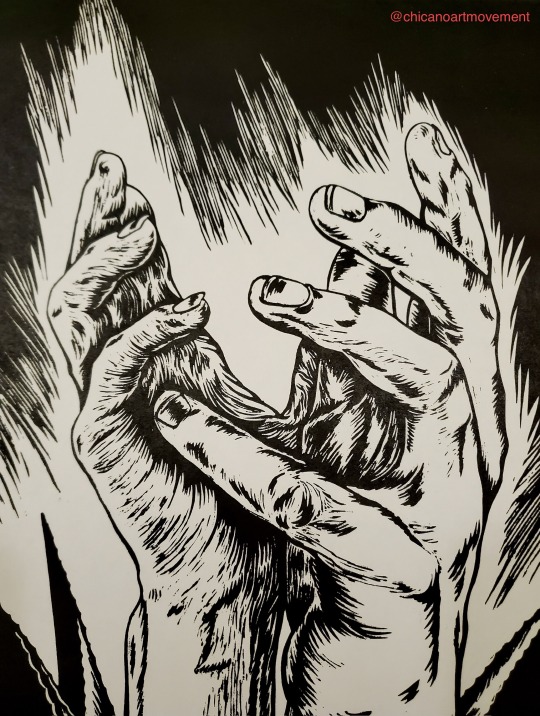
(Detailed view #1 of “Las Manos de Aztlán”)
When asked why the medium of linocut was used, Emmanuel stated that it was his preferred style since he studied specifically printmaking in the woodblock linoleum cut format both at the undergraduate and graduate levels at San Francisco State University (B.A. 1985 and M.F.A. 1991). He explained: “I sort of studied in school but I was also inspired to study to develop my own style, my own interest, in linocut and printmaking. From the tradition and history of printmaking in Mexico. I was very inspired by the work of a number of different Mexicano printmakers in the mid 19th century, the Mexican Revolution. Out of that came so much culture and art and one of those organizations was Taller Gráfica Popular…artist workshop. It was founded in 1935 by Mexicano, Leopoldo Méndez, he along with a number of Mexicano artists and printmakers established this organization TGP [el Taller de Gráfica Popular]. How I can I say this? For me, it was inspiration, it was you know, it was my roots as Chicano artist, as a Chicano printmaker specifically, and I just, you know, did a lot of, how can I say this…research, read, and went down to Mexico…Mexico City…and meet some of those printmakers…Yes, I was…you know, it was my mecca.” He laughed as he recollected his inspiration which has not waivered at all, and has only gotten stronger since his youth.
We inquired more about that trip to El Taller and Montoya was glad to share that “it was such an inspiration…such an opportunity to meet some of those artists in person and trade artwork. And este, in 1985, el Taller was celebrating its 50 year anniversary and so they had a show at Bellas Artes in Mexico City. One of the artists that I specifically meet close to, and became good friends with Alberto Beltran. I met him through another Mexicano artist that was up here [California] in the ‘80s, working with muralists up here, Mexicanos/Chicanos muralists up here. I was introduced to him; Alberto and I became good friends. We communicated, correspondence, and I would send him materials - books, information about the arts as they were happening up here in the Chicano communities. And so, 1984 I got a chance to go down and actually meet him for the first time. And I spent a good time…20 years corresponding back and forth. All those letters and information that he would send me; I saved, I collected, and it is now housed in the Bancroft Library at UC Berkeley [...] He turned me onto all these other artistas: Arturo García Bustos, Alfredo Zalce - was one of the founders of El Taller and he was in Morelia. I had a chance to go out to Morelia and meet Alfredo Zalce. It was so inspiring and it was so historical for me to meet these artists that I had read about and saw their work. It was a delight.”

(Detailed view #2 of “Las Manos de Aztlán”)
Anita further inquired how that inspiration from visiting the artistic mecca of Mexico, El Taller, helped him with his techniques when making the print “Las Manos de Aztlán” for UC Santa Cruz; Montoya responded: “Yes…in 1989, I have been doing printmaking. I studied and did my graduate work in printmaking and my thesis was also in printmaking and actually, I wrote about the connection with Chicano printmakers and with the history and tradition of Mexican printmakers [...] The tradition of Mexican printmakers at that time, at El Taller, it was important to them to create things that reflect their times, you know. And it was work based in realism, you know, something to work with…to…the work that they did that reflected the revolution or reflected their history as Mexicanos, their history as pre-Columbian, Native peoples. It was all so inspiring and of course, for me being here in the Bay Area. I was born in Texas and came to California, came to the Bay Area in 1964. And have been here in the bay Area ever since. Went to school here; got involved in Chicano Art and Chicano Culture, and the Chicano community. A lot of that was inspired by what was happening in other communities across the country, in the midwest, in Texas, in Arizona, in Southern California area. It was all this, how can I say it, birth of activism…very much.”
Activism and resilience are some of the recurring themes within the vast works by Emmanuel C. Montoya - both big and small pieces. Montoya was glad to hear that CHICANO ART MOVEMENT had visited his works in the Bay Area via trips to:
CHICANO ART visits: San Francisco Public Library, Mission Branch 2013
CHICANO ART MOVEMENT visits: SFO Museum at San Francisco International Airport (SFO), California 2014.
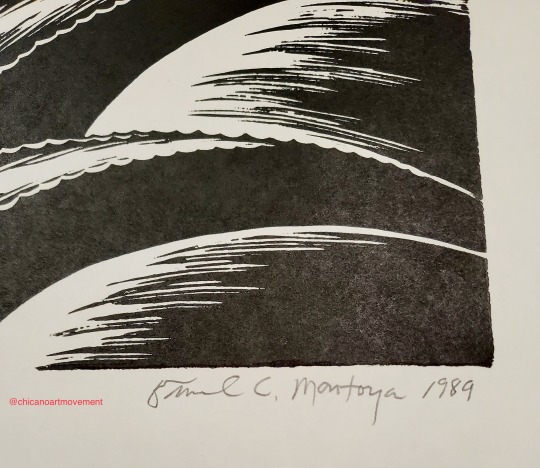
(Detailed view of artist’s signature on “Las Manos de Azltán”)
To close the interview with the great artist Montoya, it was asked if he could share more about the term Apachicano as well as any projects that he was currently working on at his studio, Apachicano Art Productions. Emmanuel stated: “I am Apache and I am Chicano. I guess one day I decided to just put the two together. (Chuckles) My history as an Apache with that culture…many years…a chingado…in the past, I would say that for 40 years or so that I have become aware that I am Apache, I am Native American and what that means and how that’s reflect in the work that I do as an artist, as a print maker [...] I am retired [and] I work out of a studio; I have been for the past 35 years now here in Berkeley. I have produced quite a bit of work.”
During our final exchange, Emmanuel kindly extended an personal invitation to visit him and his taller in Berkeley and we in return, thanked Emmanuel for the honor to interview him and for the opportunity to learn more about him, his trajectory, his community work, and some of the unknown Chicana/Chicano art history.
#emmanuel c montoya#chicano art#bay area#san francisco#uc santa cruz#chicano anniversary#chicano artist#berkeley#texas#linocut#art print#apachicano#california art
5 notes
·
View notes
Text

Kathleen Keifer (American, b. 1963, based in California), The Beverly Hills, 2024. Acrylic on canvas, 16 × 20 in | 40.6 × 50.8 cm. (Source: Artspace Warehouse)
#art#artwork#modern art#contemporary art#modern artwork#contemporary artwork#21st century art#21st century modern art#21st century contemporary art#American art#landscape art#California art#Californian artist#suburban landscape#Southern California#Los Angeles#Beverly Hills#Kathleen Keifer#California Dreaming#Made in LA
4 notes
·
View notes
Text
Macro Moments: A Textured Journey Through Everyday Fabrics by Jade Ann Byrne
Macro Moments: A Textured Journey Through Everyday Fabrics By Jade Ann Byrne Art can be found in the simplest of textures and the most overlooked corners of our lives. With the precision of an iPhone 14 Pro Max and a keen artistic eye, I’ve explored the hidden worlds of color, weave, and texture in items we wear, use, and live with daily. Each of these macro photographs represents a story, a…
#2024#American Eagle sweater#Americana style#Art#artistic collaboration#artistic fabrics#Authenticity#California#California art#California couture#California eGirl#California eGirl culture#Carhartt brand legacy#Carhartt hoodie#ClassicalInfluence#Colombia wool socks#detailed textile shots#digital art#eGirl aesthetics#eGirl branding#eGirl secrets#eGirl universe#egirl4rent#EGirlStyle#everyday art#fabric texture art#FashionFusion#Flavorful moments with Jade#handcrafted textures#hidden beauty in objects
0 notes
Text


Plein air painting of an old family owned tow company, in Winters CA. Oil on panel
#oil painting#painting#art#fine art#original art#traditional art#art study#pleinair#urban art#urban painting#autumn trees#city trees#fall trees#California art#outdoor art
24 notes
·
View notes
Text

The above image is of Jessie Homer French’s Mapestry California 2012, 2012 (fabric, thread, fabric paint, and pen), which was on view in 2018 at Palm Springs Art Museum.
From the museum about the work-
This work is from a series of “mapestries” that the artist made between 2012-2017. These textile works graphically map out natural elements and forces in California, from prominent flora and fauna, natural monuments and mountain ranges, as well as hidden fault lines that spur the earthquakes that constantly threaten the region and its inhabitants. The work reflects the artist’s hyperawareness of the environment around her. Their flat, graphic qualities are similar in form to the artist’s paintings. The mapestries were made specifically for Californians, as artworks that could do no harm hanging over one’s bed in case of an earthquake.
One of her paintings is currently part of the benefit exhibition Art for a Safe and Healthy California at Gagosian Beverly Hills. The exhibition, presented by Jane Fonda, along with the gallery, is raising money to protect communities from toxic oil drilling.
#Jessie Homer French#Art#Palm Springs Art Museum#Art Shows#California Art#California Artist#Collage#Earthquake Proof#FBF#Gagosian#Gagosian Gallery#Gagosian Gallery Beverly Hills#Landscape#Landscapes#Los Angeles Art Shows#Map of California#Mapestry#Mixed Media Art#Painting#Sculpture#Tapestries
0 notes
